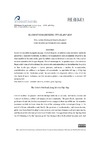Identificador persistente para citar o vincular este elemento:
https://accedacris.ulpgc.es/handle/10553/58525
| Campo DC | Valor | idioma |
|---|---|---|
| dc.contributor.author | González García-Mamely, Francisco Javier | - |
| dc.date.accessioned | 2019-12-16T16:21:52Z | - |
| dc.date.available | 2019-12-16T16:21:52Z | - |
| dc.date.issued | 2015 | - |
| dc.identifier.issn | 1136-3169 | - |
| dc.identifier.other | Dialnet | - |
| dc.identifier.other | WoS | - |
| dc.identifier.uri | https://accedacris.ulpgc.es/handle/10553/58525 | - |
| dc.description.abstract | La oratura en África ha jugado un papel vital a lo largo de los milenios como un (único) medio de preservar y transmitir la historia, la cultura y el imaginario de cada comunidad. El griot es un claro modelo de las artes orales, pero ha sufrido cambios drásticos en su modo de vida y en los recursos narrativos de los que dispone. Tras el mecenazgo de los grandes reyes y las sucesivas llegadas del islam, el colonialismo y los procesos de modernización y occidentalización, los griots se han tenido que adaptar a nuevos patrones, audiencias y medios de comunicación, convirtiéndose en políticos o en figuras del espectáculo. La aparición del rap y el hip-hop reclamando ser los “modernos griots” ha ocasionado una respuesta crítica y una atracción viral hacia el nuevo fenómeno, sea éste un nuevo género o una reinvención de la oratura del antiguo griot. | - |
| dc.description.abstract | Orature in Africa has played a vital role through millennia as a(n only) medium to preserve and transmit the history, culture and imagery of each community. The griot clearly represents the performer of oral arts, but has experienced severe changes in their way of life and the narrative resources available to them. From the time of the patronage of the ancient great kings to the arrival of Islam, colonialism and, finally, the processes of modernization and westernization, griots have been forced to adapt to new patrons, new audience demands and new mass media, and they have lately become politicians or showbiz stars. The appearance of rap and hip-hop from the US claiming to be the “modern griots” has brought about both critical response and viral attraction to this new phenomenon, whether it be a new genre or a reinvention of the ancient griot’s orature. | - |
| dc.language | spa | - |
| dc.relation.ispartof | Philologica canariensia | - |
| dc.source | Philologica canariensia [ISSN 1136-3169] (21), p. 25-44 | - |
| dc.subject | 570107 Lengua y literatura | - |
| dc.subject.other | Literatura africana | - |
| dc.subject.other | Hip-hop | - |
| dc.subject.other | Griot | - |
| dc.subject.other | Oratura | - |
| dc.subject.other | African literature | - |
| dc.title | El griot no ha muerto, viva el hip-hop | - |
| dc.title.alternative | The Griot is Not Dead, Long Live the Hip-Hop | - |
| dc.type | info:eu-repo/semantics/article | - |
| dc.type | Article | - |
| dc.identifier.isi | 000437525800002 | - |
| dc.identifier.url | http://dialnet.unirioja.es/servlet/articulo?codigo=5267388 | - |
| dc.identifier.eissn | 2386-8635 | - |
| dc.description.lastpage | 44 | - |
| dc.identifier.issue | 21 | - |
| dc.description.firstpage | 25 | - |
| dc.relation.volume | 21 | - |
| dc.investigacion | Artes y Humanidades | - |
| dc.type2 | Artículo | - |
| dc.contributor.daisngid | 27500005 | - |
| dc.contributor.authordialnetid | 1682365 | - |
| dc.identifier.dialnet | 5267388ARTREV | - |
| dc.description.numberofpages | 20 | - |
| dc.contributor.wosstandard | WOS:Garcia-Mamely, FJG | - |
| dc.date.coverdate | 2015 | - |
| dc.identifier.ulpgc | Sí | es |
| dc.description.esci | ESCI | |
| dc.description.dialnetimpact | 0,0 | |
| dc.description.dialnetq | Q4 | |
| dc.description.erihplus | ERIH PLUS | |
| item.fulltext | Con texto completo | - |
| item.grantfulltext | open | - |
| crisitem.author.fullName | González García Mamely, Francisco Javier | - |
| Colección: | Artículos | |
Visitas
146
actualizado el 01-nov-2024
Descargas
78
actualizado el 01-nov-2024
Google ScholarTM
Verifica
Comparte
Exporta metadatos
Los elementos en ULPGC accedaCRIS están protegidos por derechos de autor con todos los derechos reservados, a menos que se indique lo contrario.
